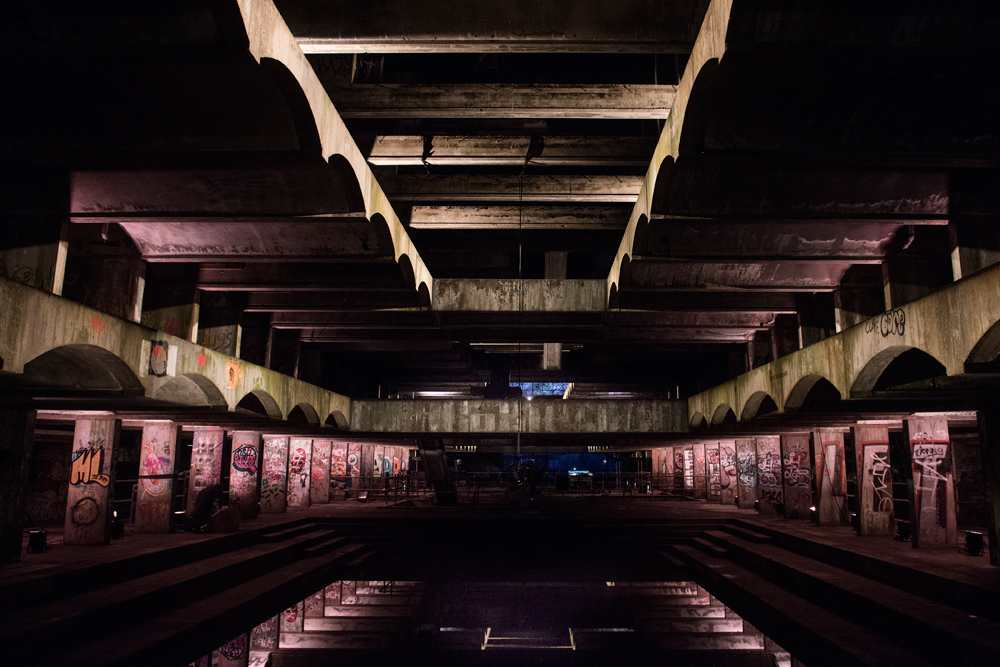Art Brut
Will brutalism’s greatest legacy be its influence on artists?
Will brutalism’s greatest legacy be its influence on artists?

Brutalism is back. Or at least the idea of brutalism is – its layers of history reinterpreted and ‘reimagined’. In Scotland, St. Peter’s Seminary – built in 1966; abandoned in the late 1980s – has been in the headlines thanks to public art producer NVA’s Hinterland, a light and sound performance that ramped up the other-worldly presence of this modernist ruin. Approached on foot through woodland, Andy MacMillan and Isi Metzstein’s concrete school for Catholic priests near the village of Cardross, an hour’s drive north west of Glasgow, became a site of architectural pilgrimage: more than 8,000 people viewed the production’s ten night run, from 18 –27 March, the building’s original religious function subsumed by the drama of its still robustly beautiful form. Its exposed carcass picked out in colours and search lights, Hinterland was brutalism gone soft – a big hug after years of indifference. NVA plans to turn the site into a permanent performance and exhibition space – public funding of £4.2 million was confirmed in March, neatly coinciding with broadsheet reviews of this architectural spectacle.

Just as brutalism’s uncompromising angles and unbending ideas took inspiration from the work of artists – the cubism of Picasso and Braque to the sculptures of Eduardo Paolozzi – so in turn have artists been drawn to the paradoxical decline of these imposing edifices. It was an artist’s work that introduced me to St. Peter’s over a decade ago: Toby Paterson’s painting Seminary in a Woodland Setting (2003). The woodland context removed, the building was untethered from the ground, its form resembling some kind of sci-fi space station, a reminder that this discarded wreck was once boldly looking to the future. NVA now talks of ‘a future reclaimed’ and ‘an incredible and unique permanent cultural venue’ – which sounds a bit like a 21st century culture industry remix of something those champions of New Brutalism, Alison and Peter Smithson, might have said.

St. Peter’s Seminary isn’t the only brutalist building being repurposed by artists. In Sheffield, the Grade II listed Park Hill housing estate, built in 1961 by Jack Lynn and Ivor Smith, is to be the new home of artist-led gallery and studios S1 Artspace. The UK government pledged £1 million to the scheme in the recent budget; with a projected completion date of 2020, a derelict 6,200m2 wing of the estate will be converted into studios, live-work spaces, a gallery and more. There will be a sculpture park, too – not quite the vision of social housing and streets in the sky that was originally intended, but clearly a desirable complement to the ‘luxury’ apartments that are gradually taking over Park Hill. Working with spray paint and concrete, Sheffield-based artist Mandy Payne has spent the last few years recording the still-to-be redeveloped parts of the estate – Brutal (2013), her starkly geometric painting of a walkway leading to flats, was shortlisted for the 2014 John Moores Painting Prize. This year’s Art Sheffield festival (16 April – 8 May) is using Park Hill and the solidly brutalist, bunker-like Moore Street electricity station as venues for work by artists Mark Fell, Michel Auder and Steven Claydon.

Both Park Hill and Moore Street are featured in the recently published Concrete Concept by Christopher Beanland (Frances Lincoln, 2016), a lively journey around the world’s brutalist buildings. Considering the renewed interest in brutalism’s hammer fist forms and ideological certainties, Beanland concludes: ‘Ultimately… it’s a nostalgic exercise, and nostalgia is the preserve of a culture with something missing.’ The London-based artist Jessie Brennan is keenly aware of this, and in particular the tendency to focus on the ideas and forms of brutalism without reference to the people that use or live in these buildings. For Brennan, the ‘something missing’ is the notion of architecture with a social purpose; the helping hand of a benign state.

Brennan’s brutalist pile of choice for her 2014-15 project and book, Regeneration!, was the Smithsons’s Robin Hood Gardens in Poplar, East London – a council estate completed in 1972 and described in Beanland’s book as ‘strange’ and ‘haunted’. Lamenting the fact that debates around its successes and failures have so often ignored its residents, Brennan attempts to explore ‘the qualities of lived-in brutalism and the personal impacts of redevelopment’. (The estate is scheduled for demolition, to be replaced with new, high density homes.) Conversation Pieces (2014), a series of graphite rubbings of residents’ doormats, evokes the greyness of concrete while offering a glimpse of human character. A Fall of Ordinariness and Light (2014) takes its title from a 1970 book by the Smithsons: four crumpled, meticulously detailed graphite drawings of a section of Robin Hood Gardens show the building gradually collapsing – social progress in reverse.

For Brennan, turning these homes into an arts centre or a heritage attraction would be a betrayal of the ideas the estate represents. Luxury flats even more so. Writing in Regeneration!, she says: ‘… we hope that social housing, like the spirit of a dormant brutalism, has the potential to rise and disentangle itself from the logic of capitalist profit, and simply be a place to live.’ Describing Robin Hood Gardens as ‘an impostor on a neoliberal landscape’, Brennan’s work celebrates the intentions of the Smithsons’s architecture – even as this brutalist landmark is readied for destruction.






















